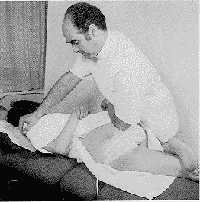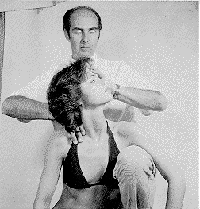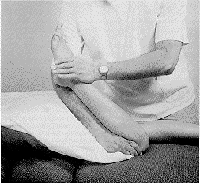Direct Techniques. In these methods the practitioner attempts to overcome limitations to normal movement by taking the joint involved towards, or through, the restrictive barrier that is preventing normal motion. This might involve thrust techniques in which, after careful positioning of the hands in relation to the joint, a high velocity, low amplitude thrusting movement forces the bony articulation to move. There would be very little movement of the hands, or of the joint in question, in such a manipulation. A matter of only a centimetre or less of actual movement might take place, but at very high speed. This might be compared to trying to move a drawer that is jammed. Pushing slowly on it, however hard, will often fail to shift it, whereas a sharp tap at the appropriate angle releases it instantaneously.
 |
This direct action, high velocity, low amplitude manipulation involves the precise localization of the forces required to allow correction of the particular dysfunction. This is achieved by means of rotation and sidebending of the patient's spine, followed by the adjustment. |
 |
This direct action manipulation positions the patient so that by extending, side-bending and rotating the neck a locking of joint facets is obtained which localizes the forces preparatory to the high velocity, low amplitude thrust being delivered to the appropriate vertebrae (in this case the second thoracic vertebrae. ) |
A different direct method of OMT is known as articulatory technique. In this the restricted joint may be repeatedly taken through its free range, up to the point of restriction, in an attempt to gradually force a greater range of mobility, with more freedom of movement. This type of manipulation often employs leverage to achieve its aims, and, as always, the longer the lever the greater the force that can be applied. A knee joint, for example, may be mobilized by the joint itself being stabilized, whilst the lower leg is grasped at the ankle and taken through a range of movements. The lower leg thus becomes a lever, and depending upon the skill with which the leverage is applied around the fulcrum (the knee joint) a great deal of controlled force can be brought to bear on the motion barriers, or on restricted tissues and surfaces. This is essentially a low velocity (slow moving), high amplitude, type of manipulation.
 |
This direct action technique enables the practitioner to use leverage to force into its correct anatomical position a posterior subluxation of the head of the fibula. |
Muscle Energy Technique (MET) is a further method of applying direct action to a restricted area. With MET, however, it is the patient's own forces which produce the manipulative effort. By placing a joint in a precise position, and calling on the patient to use a muscular effort in a particular direction, against a distinctly executed counter-force from the practitioner, it is frequently possible to achieve dramatic improvements in joint mobility. The skill in such a manouevre is in creating a balance of forces which can operate precisely on the restriction. In general terms MET involves placing the joint in question at the limit of its possible motion, in the direction in which it is most restricted. This position is maintained (not exaggerated) by pressure from the practitioner and, in a controlled manner, the patient then attempts to move the joint, by sustained effort, against the practitioner's counterforce. No movement should take place during repeated short or long efforts of this type. After each such effort the joint should be reassessed, and if the range of movement has increased then the joint should be taken to this new limit before the next attempt. This method is virtually painless, and is suitable for self-use in many areas of the body (fingers or elbow, for example).